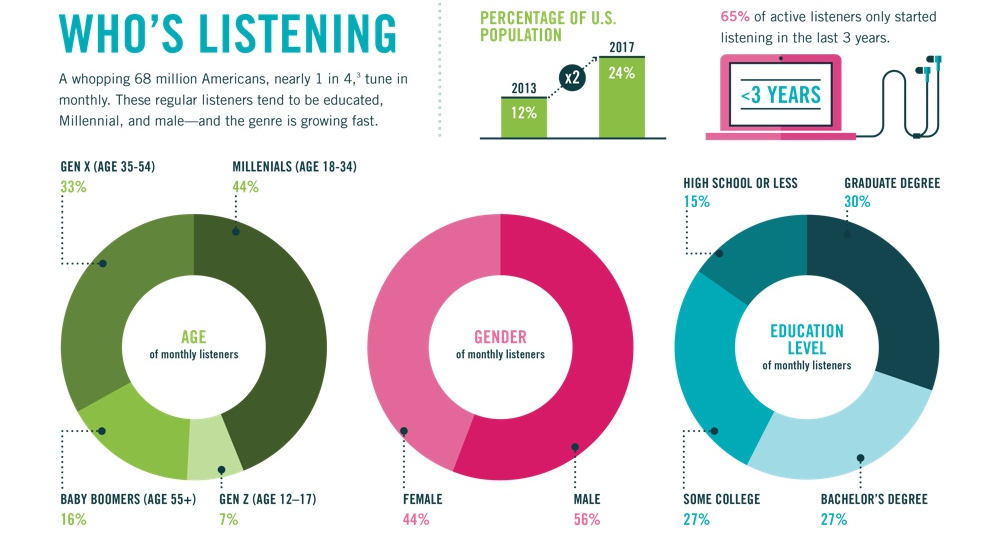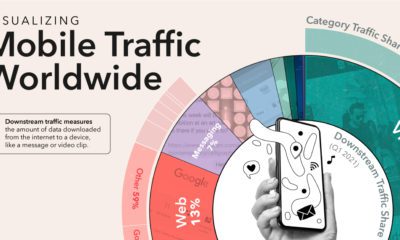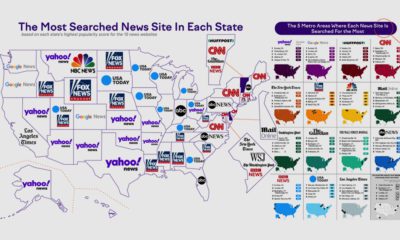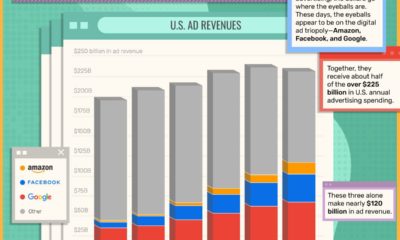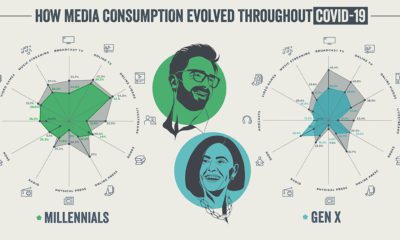Technology
The Podcasting Boom Explained

The Podcasting Boom Explained in One Infographic
The impact of technology on how we consume information cannot be understated.
The most seismic shift has been to the media landscape as platforms like Facebook overtake traditional channels of news, distribution, and advertising. Not only does this put incumbent news conglomerates in an unenviable position, but it has also thrust tech companies into the reluctant role of the gatekeeper for society’s most important news and information.
While people may be divided on whether this is good or bad, there is another major change stemming from technology that is more clean cut in having a positive effect on consumers. The internet has allowed the news and content we consume to migrate away from centralized and capital-intensive sources (radio shows, cable TV), opening up many new and digestible formats of storytelling that were never before imaginable.
The barrier of entry for content has dropped towards zero, and it allows for many different “laboratories” to test new ideas, formats, and concepts until the winners are found.
New Formats to Experience
We are obviously advocates of the growing role of the visual medium for storytelling, which we aim to do mainly through infographics and data visualizations. While people have used visual storytelling since the cave drawing days, technology has really allowed this medium to hit a new stride as a way to break through the clutter. Further, science says that people crave visual content, and infographics provide a shareable, intuitive, distilled, and thought-provoking approach to sharing data.
Like infographics, the podcasting format – which is the subject of today’s post from Concordia University – has also recently began hitting a sweet spot for audiences around the world. This convenient audio format has been made possible through technology, and doesn’t rely on the same entrenched distribution channels as old school formats, such as radio.
As a result, podcasters can experiment more with the structures of their craft, while avoiding traditional forms of censorship. Today’s podcasts are breaking new ground daily with unique content that falls anywhere on the spectrum, from improvisational comedy to fact-dense educational features.
The Podcasting Boom
The podcast, a name originating from a portmanteau of “iPod” and “broadcast”, was first coined in 2004 by journalist Ben Hammersley of the BBC and The Guardian.
Despite being a feasible form of content even during the age of MP3 players and early broadband connections, the format has only really hit the mainstream in recent years. It’s hard to explain why, but most experts point to increased mobility, better production value, and a group of content creators that have recently managed to capture the imagination of the broader public.
Regardless, in recent years, the podcasting space has boomed to new levels of popularity. Today, the percentage of Americans that listen to podcasts is 24%, which is double what it was in 2013.
Further, the advertising market for podcasts is growing as well. In 2015, the ad market for podcasts was $69 million – but by 2017, the market was triple the size at an estimated $220 million. Podcasts allow advertisers to tap into very specific audience psychographics, and podcasts offer higher CPMs ($25-45) for successful publishers than traditional online content ($1-$20).
When and Where?
Aside from allowing new types of content to blossom outside of traditional distribution channels, podcasting has one other defining characteristic: mobility.
Just as streaming does for video, podcasts allow audio to be played in many situations where it was previously less feasible for a user to curate content. In fact, people listen to podcasts the most while driving (52%), traveling (46%), walking, running, or biking (40%), commuting on public transportation (37%), and while working out (32%).
This carves a pretty interesting niche that video and other content types can’t fill. And if podcasting content keeps getting better, people may even opt to listen in at other times outside of travel, building out the medium to even bigger heights.
Technology
Visualizing AI Patents by Country
See which countries have been granted the most AI patents each year, from 2012 to 2022.

Visualizing AI Patents by Country
This was originally posted on our Voronoi app. Download the app for free on iOS or Android and discover incredible data-driven charts from a variety of trusted sources.
This infographic shows the number of AI-related patents granted each year from 2010 to 2022 (latest data available). These figures come from the Center for Security and Emerging Technology (CSET), accessed via Stanford University’s 2024 AI Index Report.
From this data, we can see that China first overtook the U.S. in 2013. Since then, the country has seen enormous growth in the number of AI patents granted each year.
| Year | China | EU and UK | U.S. | RoW | Global Total |
|---|---|---|---|---|---|
| 2010 | 307 | 137 | 984 | 571 | 1,999 |
| 2011 | 516 | 129 | 980 | 581 | 2,206 |
| 2012 | 926 | 112 | 950 | 660 | 2,648 |
| 2013 | 1,035 | 91 | 970 | 627 | 2,723 |
| 2014 | 1,278 | 97 | 1,078 | 667 | 3,120 |
| 2015 | 1,721 | 110 | 1,135 | 539 | 3,505 |
| 2016 | 1,621 | 128 | 1,298 | 714 | 3,761 |
| 2017 | 2,428 | 144 | 1,489 | 1,075 | 5,136 |
| 2018 | 4,741 | 155 | 1,674 | 1,574 | 8,144 |
| 2019 | 9,530 | 322 | 3,211 | 2,720 | 15,783 |
| 2020 | 13,071 | 406 | 5,441 | 4,455 | 23,373 |
| 2021 | 21,907 | 623 | 8,219 | 7,519 | 38,268 |
| 2022 | 35,315 | 1,173 | 12,077 | 13,699 | 62,264 |
In 2022, China was granted more patents than every other country combined.
While this suggests that the country is very active in researching the field of artificial intelligence, it doesn’t necessarily mean that China is the farthest in terms of capability.
Key Facts About AI Patents
According to CSET, AI patents relate to mathematical relationships and algorithms, which are considered abstract ideas under patent law. They can also have different meaning, depending on where they are filed.
In the U.S., AI patenting is concentrated amongst large companies including IBM, Microsoft, and Google. On the other hand, AI patenting in China is more distributed across government organizations, universities, and tech firms (e.g. Tencent).
In terms of focus area, China’s patents are typically related to computer vision, a field of AI that enables computers and systems to interpret visual data and inputs. Meanwhile America’s efforts are more evenly distributed across research fields.
Learn More About AI From Visual Capitalist
If you want to see more data visualizations on artificial intelligence, check out this graphic that shows which job departments will be impacted by AI the most.
-

 Mining1 week ago
Mining1 week agoGold vs. S&P 500: Which Has Grown More Over Five Years?
-

 Markets2 weeks ago
Markets2 weeks agoRanked: The Most Valuable Housing Markets in America
-

 Money2 weeks ago
Money2 weeks agoWhich States Have the Highest Minimum Wage in America?
-

 AI2 weeks ago
AI2 weeks agoRanked: Semiconductor Companies by Industry Revenue Share
-

 Markets2 weeks ago
Markets2 weeks agoRanked: The World’s Top Flight Routes, by Revenue
-

 Countries2 weeks ago
Countries2 weeks agoPopulation Projections: The World’s 6 Largest Countries in 2075
-

 Markets2 weeks ago
Markets2 weeks agoThe Top 10 States by Real GDP Growth in 2023
-

 Demographics2 weeks ago
Demographics2 weeks agoThe Smallest Gender Wage Gaps in OECD Countries
